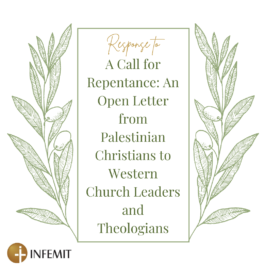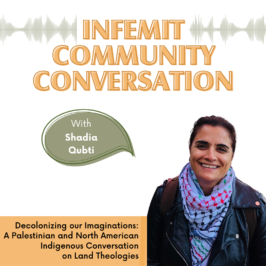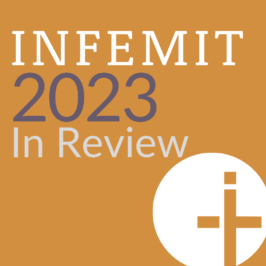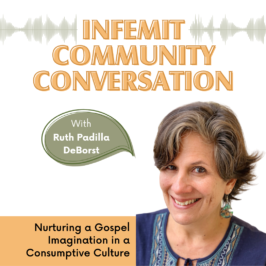English transcript
Hi everyone. Thank you, INFEMIT, for giving me this opportunity to show my work. I actually didn’t have this big audience before so this is the first time that I’m showing it to more people, and I’m really excited, and I’m really honored to be doing this with INFEMIT.
So, to begin with: My project kind of has the idea of merging different concepts that were important for me in the past couple of years. One is to think about contextualization of my faith, having moved to Canada and changing where I lived and the culture, obviously. I really wanted to rethink my roots, rethink my culture, and that was at the back of my mind as I was studying my theology degree in Regent college. And then, the other thing that came as I was studying was the concept of liturgy and specifically the liturgical year. So I put those two together and – I’m a graphic designer, so I express myself visually – and so I created a calendar or a series of posters that represent the liturgical year based on Andean culture, on textile art from Bolivia, and also just thinking about what it means to follow the calendar in South America. So, let me walk you through my gallery!
This is the first piece that I did. It’s advent, and it was the hardest one to do, because it was when I basically had to put everything that was in my head down to the screen, in this case, because it’s digital illustration. But, I’m really happy with the results, and I’m just going to mention a few details here of the piece that I created because I had to basically rethink what Advent means in Bolivia – in South America when it’s not winter, and it’s not dark. And it’s like all the things that you usually hear from Advent, it doesn’t really work in South America. So, what does it mean to follow Advent when it’s summer or when it’s spring? And so I looked into the agricultural calendar, and it’s basically from September to December is the planting season. It’s when seeds are laid down and actually farmers pay respect to the land, to Pachamama, to Madre Tierra, because it’s a time where seeds are put down in the hope of life to happen, in the hope of the land to be fertile. So I really married that concept with obviously Mary and the expecting Jesus and this idea of just waiting for life to happen. And I really wanted to show that here, so you see symbols of growth, symbols of seeds, of planting, water, and then you have a kind of like a mountain representing Mother Earth, and it’s like coming to life. And then underneath it you can see it’s a group of women coming together because in the agricultural calendar it’s the fertile season and it’s known to be the female or the feminine season of the year. So that’s my interpretation of Advent in Bolivia, and I used a bit of the colors of the liturgical calendar which are for Advent, they’re blue, but I also wanted to use green to represent the growth and also spring that is happening in Bolivia.
Followed by Advent is obviously Christmas, and I reimagined the Christmas story but in Bolivia how it would happen – how it could have happened, if it was in Bolivia. So I did Joseph and Mary as “cholita” and “cholito.” Joseph is playing the zampoña and has the traditional clothing; so also is Mary. And down there we have the three “cholitas” – that’s a very common symbol: the cholitas, and I think it’s called “las chismosas.” I think we’ve seen that in many parts of South America, but I wanted to use that, kind of referencing that, in this story, the cholitas are the three shepherds: so, the shepherds that heard the news about Jesus, and they went down to look for him. So, here are the cholitas coming to see Jesus. And also it’s the season of where you see the first harvest, so you see a bit of quinoa to the right and you see corn to the left, that are two main agricultural foods that are cultivated in Bolivia. So, I wanted to really represent what is happening in the land over all these posters, so that’s why you see the little dots here: the quinoa and, on the left, you see corn, and you’ll see them throughout some of the pieces.
Okay, so the next poster is about a season that I actually wasn’t really aware of until I came here, and it’s not that mentioned I think in South America or in my evangelical tradition, but it’s Epiphany, and it’s a time between christmas and Lent. So, it’s a time where you see the miracles of Jesus, you see the baptism, you see different stories, but the one that I chose to represent was the baptism of Jesus, and the way I reimagined it is Jesus being baptized in the Titicaca lake, and it was a really fun exercise to really imagine these things just like the story of Jesus but in different scenarios. So, here Jesus is in the lake Titicaca, and you have ducks, you have fish going on, and you have those traditional boats, and I chose the llama, the symbol of the llama on the boats, because it’s such a traditional animal in highlands, so I wanted to represent that, too. And those boats are so distinguished of or distinct from that region in La Paz, so it was fun to do, and I think they’re very unique in the way, in their style, and how they look, so I wanted to represent that. And then you have the Holy Spirit, and it’s not a dove – it’s actually a condor because in the Andean tradition, the condor is actually the messenger from the heavens to the earth, from gods to humans, so I think I wanted to kind of use that symbol to represent that in Jesus’ baptism you hear the voice, you hear the message from God to Jesus, so that’s why I use the condor in this poster. Also Advent, no sorry – Epiphany, the colors are usually white, but since I was talking about water and baptism and all of that, I really wanted to use blue, so that’s why you see a lot of blue here. And also in the festive calendar in the Andean culture, this is the season of purification, and it’s a season of water, so I really think that goes really well together with the baptism and Epiphany.
The next season in the calendar is Lent, and this one is a bit more common in Latin America, because the Catholic Church observes really well the season. So probably a lot of people have heard of it, but the evangelical church doesn’t really do anything or doesn’t have practices or traditions around this time. But what I wanted to do is think of it along the lines of the cultural background, so more between the Andean worldview, and so I asked the question: what does it mean to follow Lent? And how can I make – how would it be easier for people to understand it outside the Christian tradition? So I thought of the notion of what’s good and evil, and in the Andean worldview, it is known that harmony is really important, so whatever breaks harmony is bad, and whatever brings harmony is good. Harmony and balance are the goals, and all the things that break that are the opposite – are evil, basically. So I did this break between nature, or between people coming together, or animals flourishing, nature flourishing, and all of that on the right side; and then on the left, we have death, and we have killing, and we have war – so kind of thinking of all those things. And then the person in the middle can represent Jesus in the desert going through temptation, or it can represent you, it can represent anyone thinking of having Lent be this moment of really thinking: what is bringing harmony in my life? What is breaking the harmony in my life? So this moment of prayer – that’s what the circle around means, basically.
Then, we come to the most important part of the liturgical calendar, which is Holy Week, and it’s a week full of things that happen, and they’re very intense, and they’re very crucial to the story of Jesus, and I think this one was the most intimidating poster or piece that I did, because: how can you put down into one thing the meaning of the cross? Or the meaning of Jesus’ death and resurrection, and all of that? So, this was hard to do, but I’m happy with the results. And basically what I had to, what I did, was I put Jesus on the Andean cross that’s called the “chakana.” And this is a very important symbol in the Andean culture, and I really was fascinated about the meaning of it, because if you see it’s a cross but it kind of has angles that look like a ladder that go up and down, and then down. So it’s basically the symbol that unites three realms in the Andean culture: that is, heaven, earth, and then underworld, basically. But it’s not heaven, earth, and hell as we know it. It’s just a different understanding of it, but thinking there are three different parts of how the world is divided: “hanan pacha,” “kay pacha,” and “uku pacha.”
And so, Quechuas and Aymaras see the world like this, in this division, but the cross – the chakana – is what brings all of those three together. And I was fascinated by that concept, thinking that Jesus on the cross does that, too, because it’s bringing together God and humans and also defeating death. So, I liked how the chakana already really went well with Jesus and what Jesus did on the cross. So, that’s why the chakana is in the center. Jesus is there, too, and you have symbols of the bread and wine, like a more traditional bread, that’s an Andean cup, and then you have the branches from Palm Sunday. And then above you see the distinction of birds, so that’s like heaven, and then things that you see in the sky, basically. And then the underworld is represented by what usually, or how indigenous people represent the underworld: they see it as this place where animals take different shape, and also where the miners work. So that’s why you see miners and then you see different animals with different combinations because that’s how they represent the underworld, and I really wanted to show that in this piece. And then obviously I also added the Trinity, because I wanted to make emphasis on how it wasn’t only Jesus on the cross; it was the Holy Spirit and then it was God, the Father also there in this very crucial moment for everyone. So this is Holy Week.
After Holy Week, there comes Sunday, Resurrection Sunday, and this piece has a very different tone to it. The other one had really strong colors, and it was red, and it was almost dense and heavy. This one has more of a lighter tone, and it’s supposed to bring light and hope, because that’s what Easter is about. And here is basically my understanding of the road to Emmaus, and thinking of it as okay: what if, instead of the the road to Emmaus, it’s the Inca road, the Inca trail. So these are the two disciples walking, and then Jesus is having an encounter with them, and maybe they don’t realize at the beginning, but Jesus is there, and he’s bringing light and his embrace to the scene. And there, it’s dawn, so the colors represent dawn – like this arrival of light and hope, because Jesus is alive. And that’s what this poster means, and it’s filled with more Andean– and trying to represent the Inca trail in Bolivia that maybe some of you have done, and it was just nice picturing Jesus going through that road with with us.
The next season is Pentecost, and it’s 50 days after Easter. And it was really interesting to try to think of ways to connect it with a very important season in the Andean calendar, which is the winter solstice. And it happened to be kind of close with Pentecost – I think it happens almost in the same month, maybe a few weeks apart – Pentecost from winter solstice in Bolivia. And what I discovered trying to dig into the concept of both things is that they’re both celebrating actually a harvest, but in Bolivia it’s actually the biggest harvest, the one before winter, and so it’s usually a time where you bring all the harvest from the season and you have it blessed because, after that, winter comes and the land needs to rest. And then, in the biblical story, what we don’t usually hear is that it was also a harvest festival, and they were also celebrating with the abundance of whatever was harvested that season, and that’s actually why there were so many different people from different parts of the world coming into town because it was this festival. And so it is kind of related to the winter solstice, and I really wanted to put those two together. And so you see the basket full of goodies. You see corn obviously because it is a very important food that is cultivated, you see potatoes, you see carrots. So it’s representing the harvest. But then you see the man and the woman receiving the Holy Spirit. So, another important thing is that in winter solstice, it’s called “Inti Raymi,” is when people usually stay up all night waiting for the sun to come. And when the sun comes early in the morning, it’s really cold, they extend their hands in this motion trying to get the warmth of the sun. So it’s like, yes, we’re accepting the sun because we need the warmth after a night of vigil, right. So I like that posture, and I wanted to represent that, in this in this particular case, you are extending the hands to receive the Holy Spirit, because that’s what happens in Pentecost. You are receiving the Holy Spirit, and you’re receiving warmth and fire. So that’s what this piece represents, and it’s the coming of the Holy Spirit, and you see it up there, it’s covering everything and it’s bringing blessings to everyone. And you can see little symbols of the sun because it is the festival of the sun in the Andean culture.
And finally, at the end of the liturgical year, we come to this season of ordinary time. And it’s known to be just this time of daily activities, normal life. That’s why I kind of wanted to represent things that are very common and are more down to earth, or ordinary things, like cultivating the earth, or just working with the hands, women with children, holding children and cooking. And I didn’t want to be gender specific, or I didn’t want to be reinforcing stereotypes, but I was thinking of how people in the countryside in little towns in Bolivia actually live, and this is how they live, right. So I wanted to honor that, too. And then you see church life happening, you know, people from different age groups and everyone basically coming to church. And so ordinary time is a time just to think of your daily life. But then, in the center, this is kind of like a tree, and the tree trunk is Jesus holding everything together. So that’s kind of how I imagined that life happens, right. We do our daily stuff, but Jesus is holding us, and throughout this entire time, he’s there and he’s present, no matter how small or how maybe insignificant what you do – you might think it is – but Jesus is there, Jesus is present and is holding the life of the church and the life of people together, right. So this is ordinary time, and this is basically how the year ends, because it’s from June – no sorry – yeah, June all the way to November, and that’s when Advent restarts again. So that’s the whole year basically in the liturgical seasons.
So that’s basically all the liturgical calendar, and we can go back to the first piece that I showed you that basically shows everything. And you can tell now all the pieces that I’ve shown you. You have one little piece of Advent with Jesus as a baby, Jesus in the womb, then, Jesus is a baby, then Jesus’ baptism, then the temptation of Jesus, then the crucifixion, then resurrection, then Pentecost, and, finally, ordinary time. And I just wanted to put all of that together in one piece to have this visual idea of the whole year. And I think something that I didn’t mention before, maybe I did briefly, is that all these pieces are based on textile art of Bolivia, specifically a region in Sucre, and the amazing designs that they do. They’re just amazing and inspiring, so I really wanted to use that style of patterns and kind of geometrical forms, because that’s what they do. And in that tradition, the name for the parts they design, where the women weave different designs, it’s called “pallay.” So actually what I’ve done is they’re different pallays, right, different designs, and that’s the name of my project, because it’s a design of the liturgical calendar with the context of Bolivia and the Andean culture, and I hope you enjoy it. And, if you have any questions, please reach out, and I’m happy to talk more about it. Thank you so much.






Leave a Reply